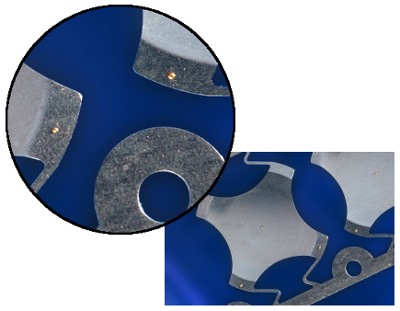 |
| March 27, 2012 | Volume 08 Issue 12 |
Designfax weekly eMagazine
Archives
Partners
Manufacturing Center
Product Spotlight
Modern Applications News
Metalworking Ideas For
Today's Job Shops
Tooling and Production
Strategies for large
metalworking plants
New process clads gold contacts with a laser

Gold contact spots on a snap dome. [Source: INOVAN]
Electroplating is the conventional method used to plate metal switches, but scientists in Germany have developed a new and novel laser-based method that involves laser-cladding gold contact spots instead of applying the gold in a thin layer on the whole surface. This technique is fast and offers the potential to cut up to 90% of the amount of gold used. Given the price of gold these days, the process is a winner all around.
Keys and keyboards have become a common sight in today's world, both in our personal lives (cars, phones, computers) and in industrial settings. Users expect keys to operate with 100% reliability, regardless of how many times they are pressed. At the same time, manufacturers are seeking cheaper production methods and new ways of making more efficient use of expensive, high-quality materials.
Researchers at the Fraunhofer Institute for Laser Technology ILT in Aachen have developed a method of producing keys on an industrial scale that fulfills both these requirements. Working in collaboration with their project partner INOVAN, the scientists have been drawing on their experience in laser cladding to replace the electroplated gold layers on switch contacts – known as "snap domes" – with small, welded gold spots.
Snap domes are small contact springs that are used to make electrical contact and provide tactile feedback in a wide range of keyboard designs. They generally consist of high-quality spring steel that is typically gold-plated or modified in some other way in order to achieve better contact and more reliable switching. As well as having low contact resistance, gold also boasts outstanding resistance to corrosion.
The new method replaces the conventional large gold surfaces with small contact spots that are cladded by a fiber laser. Using gold powder with grain diameters smaller than 10 µm, the fiber laser takes advantage of its beam diameter of less than 100 µm to create contact spots with a diameter and height of less than 100 µm. This micro laser cladding uses a nozzle to feed the gold powder into the interaction zone of the laser beam and the substrate material (e.g. stainless steel, nickel alloy). The laser energy melts both the gold powder and a thin surface layer of the substrate to create a metallurgical bond to the substrate.
Significant reduction in material consumption
One of the biggest advantages of this new method is its material efficiency. To replace the thin gold layer deposited on snap domes by conventional methods, you need just five selectively welded gold contact spots. Initial calculations suggest that this slashes the amount of material required to make the gold contact by between 50% and 90%.
The really good news: Preliminary tests carried out by INOVAN comprising 100,000 switching operations demonstrate that this new approach does not measurably affect switch service life. In addition, the electrical properties of the gold contact spots correspond to the results obtained from electroplating.
Integrated production
The laser-based method also makes it possible to integrate the fabrication of the gold contact spots into the production of the switch components themselves. This enables rolls of material to be processed and facilitates the efficient production of short-run batches and prototypes. Cladding a single point takes approximately 50 msec. Researchers are currently investigating how to accelerate the process. The experts suggest that it should be possible to weld 20 contact spots simultaneously in the future by splitting the laser beam.
Using laser cladding to produce contacts from precious metals is a method that, in principle, is suitable for all metal parts that currently rely on plating techniques to make electrical contacts. Application examples cited by the German researchers include the switches used in cell phones as well as bipolar plates for fuel cells.
Source: Fraunhofer ILT
Published March 2012
Rate this article
View our terms of use and privacy policy
